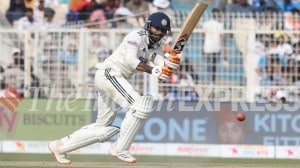The look-good revolution
Has a new aesthetic sensibility taken hold of metropolitan India? Look around these days and you find an overwhelming preoccupation with ...

Has a new aesthetic sensibility taken hold of metropolitan India? Look around these days and you find an overwhelming preoccupation with the appearance of things. Magazines and newspapers are exploding into colour. Groceries and toiletries come in smart, eye-catching packaging.
Restaurants, department stores, hotels and bars are spending a fortune cooking up new themes and new looks. People young and old, men and women, are paying more attention to their figures, their wardrobes and experimenting with trendy beauty aids. The difference is not just in the emphasis but in a perceptible decrease of kitsch and bad taste.
 In Mumbai, for instance, where I live, you could hardly walk down the street without encountering both in abundance. Today things are different: you would have to look long and hard for an old style bazar, the conical bras next to calender art kind that has found its way into so many Western representations of exotic India’. Similarly the Roopams, the Sheetals and the Benzers, swankyboutiques catering to the relatively ostentatious tastes of the nouveau riche have graduated to a quieter, less gaudy sensibility.
In Mumbai, for instance, where I live, you could hardly walk down the street without encountering both in abundance. Today things are different: you would have to look long and hard for an old style bazar, the conical bras next to calender art kind that has found its way into so many Western representations of exotic India’. Similarly the Roopams, the Sheetals and the Benzers, swankyboutiques catering to the relatively ostentatious tastes of the nouveau riche have graduated to a quieter, less gaudy sensibility.The average and certainly the upper middle class home is likely to have replaced showcases and formica with white walls, marble, veneer and plants : unimaginative but inoffensive. On the other hand there are Ikea like shops opening up not just in Mumbai but all over the country stocking crockery, linen, furniture and home accessories — in quirky shapes, bright youthful colours and contemporary materials such as glass and die cast aluminium.
There are certain easily identifiable reasons for the shift in public tastes. Indians are travelling abroad in far greater numbers than ever before and the effects of that exposure are percolating. The middle class is also demanding more quality and among its prosperous members there is a growing impatience with shoddiness. The liberalisation of imports has flooded the market with all kinds of products — pine wood floorings, Italiankitchens — and big names such as Noritake, Baccarat, Swarovsky and Morano.
Not only have choices expanded, but even the cheapest choices have become (by imitation) more aesthetically pleasing. Another significant factor is probably India’s indisputable strength in handicrafts. We export dhurries, fabric, cutlery, crockery, glass, candles, wrought iron etc. etc. all over the world. With the surplus from many manufacturers finding its way into retail outlets, our exports are returning to change us.
The middle class revolution of the eighties according to many advertisers was a convenience revolution’. Perhaps what we are now in the throes of is a revolution of aesthetics. But though the concern of the current revolution may be with appearances its implications are far from superficial.
For a fuller understanding let us consider some of its main characteristics. The most striking feature of the new aesthetic sensibility is eclecticism.
The Leegla’s recently renovated hotel in Goa for instance, aimsto recreate the glory of the Vijaynagar empire (with stone carved lions, Dholpur pink sandstone pillars) and mixes it with tropical vegetation, lagoons and Portugese villas. Mumbai’s latest hip restaurant Indigo has single glass pieces for lamps, a staircase without a handrail, a sandpaper red wall and heavy furniture (bare, minimalism, Rajasthan and the Raj).
Plonk it in London, says a much-travelled local interior designer, and it would not be out of place. Present day nightclubs echo all sorts of themes : fashion, underground, underwater, English pub, Western outpost, space age, Mexican so on and so forth. And in a reasonably affluent home it is not unusual to find Irani lampshades sharing space with Chinese pots, mock antique sideboards and velvet sheathed loudspeakers.
The ethnic Indian is no longer the rage it was. But it is far from absent. In fact you can spot the ethnic everywhere not in its familiar form. Check out the clothes worn by Hindi film actresses for instance. Madhuri Dixit’s palechiffon churidars kurtas in Dil To Pagal Hai and Aishwarya Rai’s vivid saris in the more recent Hum Dil De Chuke Sanam: the accent on form, texture and colour gave these common Indian garments a style and identity all their own. And if you walk by jewellery or lifestyle stores these days you are likely to spot a surfeit of abstract, multihued idols and images of the popular Ganesha.
These various factors, eclecticism, qualitative improvement, the imaginative use of the ethnic, though far more pleasing to the eye, have however created a sense of rootlessness, an anywhereness.
The old India was dirty, loud and disorderly. The new one is clean and pretty. Disconcertingly so. Can we really be this clean? This pretty?Seems like we can. Or at least we are trying. If Bollywood with its colour co-ordinated sets and its tendency to intersperse exotic locations with Indian ones (sometimes passing them off as part of the local scene) have created a fantasy India, then real life is snapping at itsheels.
The current fast-evolving landscape in Mumbai might just be a harbinger of things to come. The slums along the highway have been painted over in bright red and blue Coke and Pepsi colours. Flyovers are popping up all over the city. There are little bits of corporateised streets – smart pavements with elegant street lamps. A new clean Chowpatty with beach umbrellas, well tended parks and swanky multistoreyed stores. The transformation seems to be sudden enough to inspire disbelief. But then, it can be argued, it is an undeniably glamorous dislocation.































